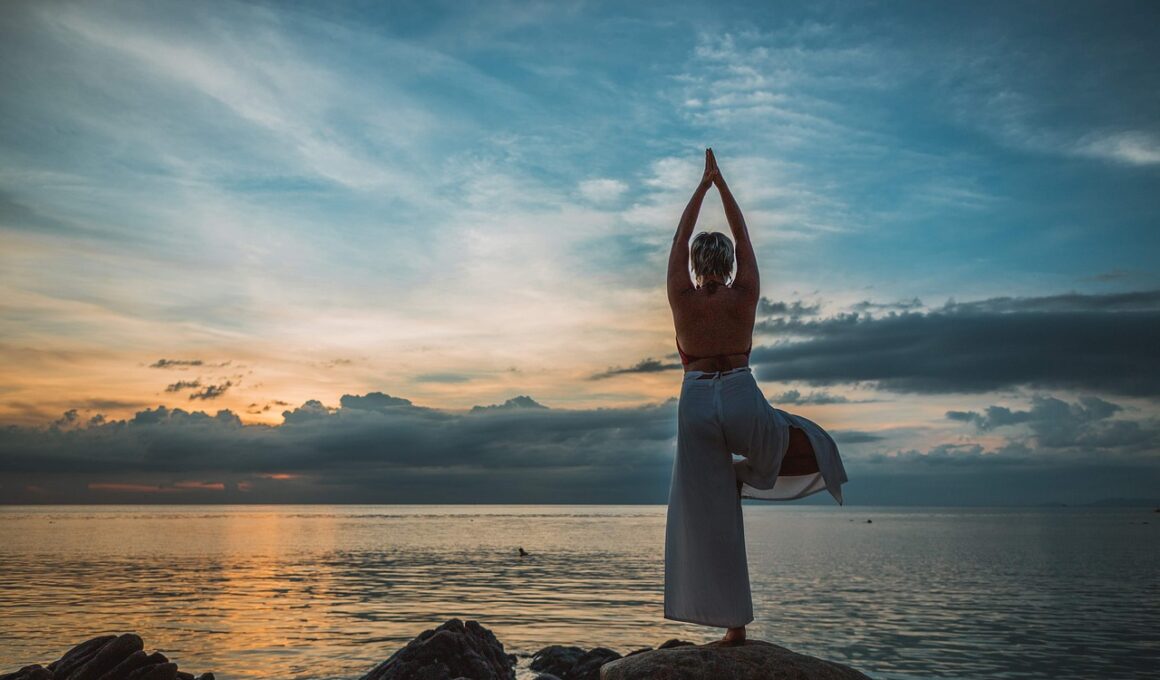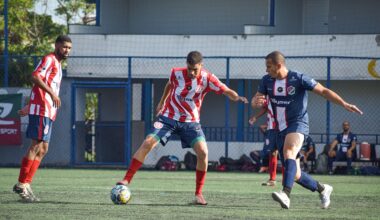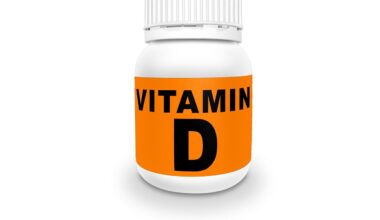From Static Holds to Flow: Blending Calisthenics and Vinyasa Yoga
Calisthenics offers a unique approach to strength training by emphasizing body weight exercises, while Vinyasa yoga introduces fluid movement sequences. Both disciplines focus on breath, posture, and the mind-body connection. Integrating these practices leads to greater strength, flexibility, and mental clarity. For those interested in starting this integration, consider beginning with foundational poses in yoga and basic calisthenics exercises. Developing a strong base enhances both capabilities, making transitions between movements smoother. Practitioners can explore various combinations, such as incorporate lunges with warrior poses or push-ups within flow sequences. Utilizing these combinations helps improve endurance and functional strength. Furthermore, listen to your body to prevent injuries during transitions, especially those between static holds and flowing movements. It’s beneficial to introduce modifications for challenging poses or movements. This practice not only enhances physical fitness but also encourages mindfulness. It fosters an environment of self-awareness and personal growth through both individual and guided training sessions. Adaptability is key when blending these disciplines seamlessly. Through careful practice, one can discover their unique rhythm, striking the perfect balance between the strength of calisthenics and the fluidity of Vinyasa yoga.
The Importance of Breath in Practice
Breath plays a foundational role in both calisthenics and Vinyasa yoga. In calisthenics, maintaining proper breath control during exercises maximizes performance and energy. Practitioners can enhance their workouts by coordinating breath with movement. For instance, inhaling during preparation and exhaling during exertion fosters a rhythmic flow. In Vinyasa, breath guides the movement, intertwining poses seamlessly through transitions. This connection creates a meditative state. It is essential to establish this connection consistently; start by focusing on the inhalation and exhalation patterns as you transition between exercises in calisthenics. Doing this creates a cohesive experience. This enhancement also cultivates greater awareness of body alignment and posture. Incorporating pranayama, or mindfulness breathing techniques, from yoga into calisthenics is beneficial. Techniques like Ujjayi breathing can enhance endurance and focus. Additionally, learning to control breath during static holds can facilitate progress toward movement flows. Developing strength through static holds, like planches or front levers, relies heavily on breath for stability. Thus, mastering breath in both disciplines allows for a deeper understanding, making workouts more effective and enjoyable. Collaborating these practices can yield profound results, elevating one’s overall fitness journey.
Static holds in calisthenics are essential for building strength and stability in various muscle groups. Popular static positions include the L-sit, planche, and handstand. These poses require significant upper body strength, core engagement, and thorough balance. It is crucial to build up gradually to these static holds, allowing your body to adapt to the demands. Practitioners should start with easier variations and slowly increase the challenge as they develop strength. For example, begin with tuck holds or bent-arm hangs evolving to a full planche. This gradual building of strength fosters not only muscle growth but also mental resilience. Integrating yoga poses such as downward facing dog can act as a great warm-up before performing static holds. Stretching the muscles before engagement is vital for preventing injuries. Static holds can help cultivate patience and focus, as holding a challenging position requires immense concentration. In contrast to flowing movements, static holds require a still presence, balancing intensity with serenity. Regular practice of static holds paired with Vinyasa flow sequences allows for a more holistic view of body control, resulting in increased physical capabilities and a more profound awareness of body movement.
Flow holds unique significance in the integration of calisthenics and Vinyasa yoga, where movement transitions become fluid sequences. The essence of Vinyasa lies in transitioning between postures while maintaining breath control. These flows challenge the body and mind, producing fluid movements that develop coordination and rhythm. To integrate these practices, begin to merge calisthenics movements such as push-ups and dips with yoga flows like Sun Salutations. For beginners, focusing on synchronizing breath during these transitions can ease the learning curve. Adding aspects of calisthenics into Vinyasa sequences promotes overall strength and stability while keeping it dynamic. Practitioners should focus on timing their movements harmoniously with breath—this aids in smoothing out transitions. Incorporating these dynamic sequences allows muscles to work in unison, thereby enhancing flexibility and balance. It’s also essential to practice mindfulness throughout flows, as this promotes self-awareness and helps prevent injuries. Listening to one’s body while transitioning can inform the need for modifications to ensure comfort. Progressing through these flows ultimately creates a deeper connection to one’s practice, leading to a heightened sense of achievement and fulfillment in personal fitness journeys.
Creating a Balanced Routine
Crafting a balanced routine that incorporates calisthenics and Vinyasa yoga requires careful planning. Consider alternating between strength training days focused on calisthenics and flexibility-focused yoga sessions. Start with two or three days of strength training each week, progressively increasing intensity by adding more challenging calisthenics exercises. Then, incorporate two days of Vinyasa yoga, ensuring you stretch the muscles worked during strength sessions. This balance promotes recovery and enhances overall body performance. Including a mix of both static holds and flow sequences can make your workouts incredibly dynamic. Aim for a harmonious relationship between strength-building and flexibly enhancing activities. Additionally, consider incorporating mobility work to improve joint health, as this benefits both practices. Rest days should not be overlooked; they are equally vital to allow muscles to recover and prevent burnout. On rest days, gentle yoga or light mobility-focused movements can encourage recovery. Tracking your progress helps in adapting the routine to your evolving fitness levels. Over time, integrate diverse variations and movements to keep your sessions engaging. A balanced routine can transform your fitness experience into a comprehensive approach, cultivating strength, flexibility, and mindfulness together.
Nutrition plays a crucial role in enhancing performance within calisthenics and Vinyasa yoga practices. A balanced diet fuels physical activity and recovery. Incorporating complex carbohydrates, healthy fats, and protein into meals is essential. Complex carbs provide energy for workouts, while proteins assist muscle recovery and growth. Hydration should not be neglected; sufficient water intake supports performance and reduces the risk of injury. Certain foods can also aid flexibility and inflammation reduction, such as fruits, vegetables, nuts, and seeds, which are rich in antioxidants and vitamins. Consider superfoods such as chia seeds and avocados to support overall physical health. Before practicing, opt for easily digestible snacks to maintain energy without causing discomfort. Post-workout nutrition is equally important; consuming a protein-rich recovery meal or shake enhances muscle repair, restoring energy levels more effectively. Meal prep can help ensure that nutritious choices are always within reach, particularly on busy days. Ultimately, observing how different foods affect energy and performance can lead to better dietary choices. Pairing wise nutritional habits with calisthenics and Vinyasa yoga enhances not only physical abilities but also overall wellness and vitality, paving the way for sustainable and enjoyable practice.
Enhancing Mindfulness through Integration
The integration of calisthenics and Vinyasa yoga fosters a deeper sense of mindfulness during practice. By focusing on breath and body alignment, practitioners enhance awareness of their movements and mental state. The meditative essence of Vinyasa encourages individuals to immerse fully in each moment. It’s about placing attention on the transitions rather than simply the end goal of a pose. Mindfulness can be developed; start by practicing basic connection techniques such as maintaining focus on breath. As skills improve, one can gradually enhance attention to physical sensations and emotional responses. Invite an intention before each practice session to enhance mental clarity. This intention acts as a guiding principle throughout the workout, honing focus and purpose. Calisthenics’ requirement for concentration during dynamic movements complements yoga’s meditative aspects, creating a holistic experience. As you cultivate mindfulness, extend this practice off the mat, fostering self-awareness in daily life. Regular reflection on personal progress in both calisthenics and yoga builds resilience, patience, and adaptability. Ultimately, the integration of these two disciplines transcends physical abilities; it nurtures personal growth and deepens feelings of grounding and calmness.


